#a 6TH ARK???
Text
trying not to get my hopes up about andromeda being incorporated into the new mass effect but also 👁👁
#went back and rewatched the 2020 trailer with cc on this time and....................#i shouldve done that 2 years ago...........#a 6TH ARK???#like the initiative arks?? but there were only 5??? so wtf???#the deliberate showing of both andromeda and the milky way in the first shot.............#i thought it was just a mean joke...like haha bye andromeda we're going back to the milky way now#andromeda has so much potential i am hoping so hard that they dont abandon it#but i dont want to get my hopes up#but also like a 6th ark.....theres no way they wont connect to andromeda somehow right....#do you think theyll do anything with the 5th ark.... i dont remember much about the book except for the virus stuff#but since it shipped after the first 4...and those got out Just before the reapers hit...the 5th ark shouldve gotten caught up in it#the 6th DEFINITELY DID#ohhh man what if its the milky way learning about the existence of the andromeda initiative....#bc the 6th ark got downed....#but who tf wouldve been on the 6th ark i thought 'the rest' were all on the 5th#sorry to my followers that dont know anything about mass effect lol but im getting excited about n7 day#and every time i think about mass effect i cry about how much potential andromeda had#the theories i have.......shit couldve been sooooo fuckin cool#it speaks#mass effect
15 notes
·
View notes
Text
okay so I'm very much an odd man out on the toaru sub for not being excited or super hyped to read gt8 and I honestly have no idea why that is so I figured I'd ask if anyone else here on tumblr dot com is feeling the same way or if it's literally just me lol
#the cover reveal like a month back the b and w illustration reveal like a week or so ago and reading the preview all did nothing for me#like idk if it's just some sorts 6th sense telling me that gt8 isn't going to be that good as a standalone volume bc it's obviously meant#to lead into gt9 and maybe even gt10 but#also I'm not a big fan of kingsford or mut's designs at all. they feel either too cluttered in mut's case or like a random mash of stuff#that doesn't show us the essence of who the character is in kingsford's case#kingsford's hat is the only thing i like about her design lol#toaru is going full vtuber/ark knights character design mode and i don't like it bc it's not being done well here lmao#mine#toaru#toaru majutsu no index#i will read gt8 once it's done being translated cause I'm in no rush to do so#idk maybe it's just this arc in general that I'm not feeling
9 notes
·
View notes
Note
The Advance question gave me another thought: your top five ShtH levels?... APART from Lost Impact and The Doom, since I know you like those ones. ;P
Lol. Hey, I like them lore-wise :P
Ranking levels in ShTH is hard because the mission will very much change your experience - Mad Matrix is bearable if you do the Neutral Mission, long but interesting if you do the Hero mission, and it should die in a fire if you do the Dark mission. I'll try...
5) Prison Island. One of the best ways to call back to a past level in the series: it's not "hey remember this game you liked?", it's "look, the events of a past game have changed the world of the series". The gimmick of the Air Saucer over rivers of acid is kind of funny, and killing all the mechs is cathartic for me. (sidenote, I never found Charmy that annoying here, and his mission is harmless) And listen to its jazzy theme!
4) Lava Shelter. One of the few levels that changes layout depending on the mission, the other being Space Gadget. I really like the mechanic here: if you go through the Dark mission, you raise the lava and you make the stage harder. Aesthetic-wise, it reminds me of Eggmanland's core, and design-wise, it reminds me of Egg Fleet or something from Heroes lol.
3) Circus Park. The only colorful level in the game :P pretty random if you're doing the Pure Hero route, Tails asks you to stop your quest against the Black Arms and get back the Rings Eggman stole lol. But Circus Park Hero is one of my favorite missions, it's Casino Park but fixed, it integrates gunplay cleverly and makes this stage one of the best "casino/circus" ones. The Dark mission isn't bad either, it's the easiest "kill all enemies" mission, and it's fun to have Eggman talk about his circus to you.
2) Air Fleet. I love the Dark mission so much because oh boyyyy let me shoot at all the stuff <3 <3 <3 and there is honest to god tricky platforming here, but not cheap!
1) G.U.N. Fortress. The level itself is pretty good, you either storm the base always in Dark Chaos Form and you rack up hundreds of hundreds of machine gun bullets, or you feel the weight of your sudden betrayal by awkwardly dodging all the mech that wants you dead. But no, I won't deny that the reason it's #1 is its place in the plot. Theme-wise, this level hits me hard. Also I will never shut up about the music.
#sonic the hedgehog#shadow the hedgehog#shth#6th and 7th place would be the ark and sky troops i believe
5 notes
·
View notes
Text
Washington Ending / Raiders March
youtube
80's Fest Movie 🎬 Score of the day: Raiders Of The Lost Ark by John Williams (1981) #johnwilliams #raidersofthelostark #IndianaJones #80s #80sfest #durandurantulsas6thannual80sfest
#john williams#raiders of the lost ark#indiana jones#80s#duran duran tulsa's 6th annual 80s fest#80s fest#Youtube#Spotify
0 notes
Photo

Kingdom of Abyssinia
The Kingdom of Abyssinia was founded in the 13th century CE and, transforming itself into the Ethiopian Empire via a series of military conquests, lasted until the 20th century CE. It was established by the kings of the Solomonid dynasty who, claiming descent from no less a figure than the Bible's King Solomon, would rule in an unbroken line throughout the state's long history. A Christian kingdom which spread the faith via military conquest and the establishment of churches and monasteries, its greatest threat came from the Muslim trading states of East Africa and southern Arabia and the migration of the Oromo people from the south. The combination of its rich Christian heritage, the cult of its emperors, and the geographical obstacles presented to invaders meant that the Ethiopian Empire would be one of only two African states never to be formally colonised by a European power.
Origins: Axum
The Ethiopian Highlands, with their reliable annual monsoon rainfall and fertile soil, had been successfully inhabited since the Stone Age. Agriculture and trade with Egypt, southern Arabia, and other African peoples ensured the rise of the powerful kingdom of Axum (also Aksum), which was founded in the 1st century CE. Flourishing from the 3rd to 6th century CE, and then surviving as a much smaller political entity into the 8th century CE, the Kingdom of Axum was the first sub-Saharan African state to officially adopt Christianity, c. 350 CE. Axum also created its own script, Ge'ez, which is still in use in Ethiopia today.
Across this Christian kingdom, churches were built, monasteries founded, and translations made of the Bible. The most important church was at Axum, the Church of Maryam Tsion, which, according to later Ethiopian medieval texts, housed the Ark of the Covenant. The Ark, meant to contain the original stone tablets of the Ten Commandments given by God to Moses, is supposed to be still there, but as nobody is ever allowed to see it, confirmation of its existence is difficult to achieve. The most important monastery in the Axum kingdom was at Debre Damo, founded by the 5th-century CE Byzantine ascetic Saint Aregawi, one of the celebrated Nine Saints who worked to spread Christianity in the region by establishing monasteries. The success of these endeavours meant that Christianity would continue to be practised in Ethiopia right into the 21st century CE.
The kingdom of Axum went into decline from the late 6th century CE, perhaps due to overuse of agricultural land, the incursion of western Bedja herders, and the increased competition for the Red Sea trade networks from Arab Muslims. The heartland of the Axum state shifted southwards while the city of Axum fared better than its namesake kingdom and has never lost its religious significance. In the 8th century CE, the Axumite port of Adulis was destroyed and the kingdom lost control of regional trade to the Muslims. It was the end of the state but not the culture.
Continue reading...
157 notes
·
View notes
Text
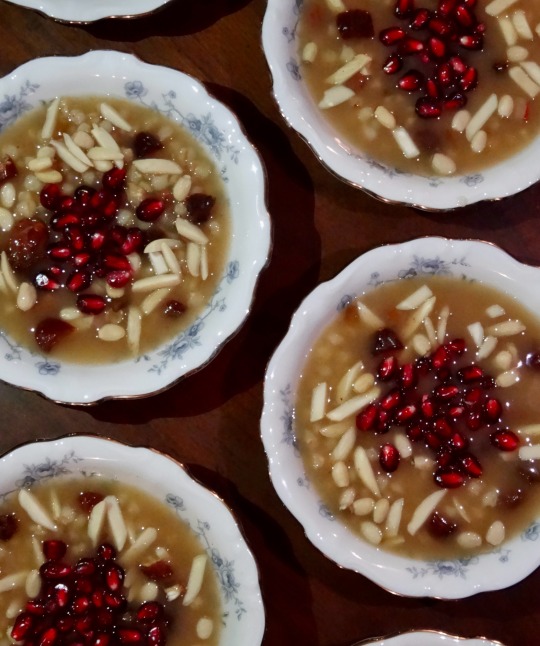
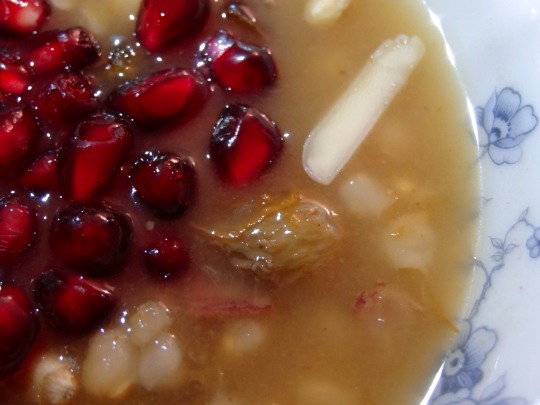
[ID: First image shows four small porcelain bowls of a pudding topped with slivered almonds and pomegranates seeds, seen from above. Second image is an extreme close-up showing the blue floral pattern on the china, slivered almonds, golden raisins, and pomegranate seeds on top of part of the pudding. End ID]
անուշապուր / Anush apur (Armenian wheat dessert)
Anush apur is a sweet boiled wheat pudding, enriched with nuts and dried fruits, that is eaten by Armenians to celebrate special occasions. One legend associates the dish with Noah's Ark: standing on Mt. Ararat (Արարատ լեռը) and seeing the rainbow of God's covenant with humanity, Noah wished to celebrate, and called for a stew to be prepared; because the Ark's stores were diminishing, the stew had to be made with small amounts of many different ingredients.
The consumption of boiled grains is of ancient origin throughout the Levant and elsewhere in West Asia, and so variations of this dish are widespread. The Armenian term is from "անուշ" ("anush") "sweet" + "ապուր" ("apur") "soup," but closely related dishes (or, arguably, versions of the same dish) have many different, overlapping names.
In Arabic, an enriched wheat pudding may be known as "سْنَينِيّة" ("snaynīyya"), presumably from "سِنّ" "sinn" "tooth" and related to the tradition of serving it on the occasion of an infant's teething; "قَمْح مَسْلُوق" ("qamḥ masluq"), "boiled wheat"; or "سَلِيقَة" ("salīqa") or "سَلِيقَة القَمْح" ("salīqa al-qamḥ"), "stew" or "wheat stew," from "سَلَقَ" "salaqa" "to boil." Though these dishes are often related to celebrations and happy occasions, in some places they retain an ancient association with death and funerary rites: qamh masluq is often served at funerals in the Christian town of بَيْت جَالَا ("bayt jālā," Beit Jala, near Bethlehem).
A Lebanese iteration, often made with milk rather than water, is known as "قَمْحِيَّة" ("qamḥīyya," from "qamḥ" "wheat" + "ـِيَّة" "iyya," noun suffix).
A similar dish is known as "بُرْبَارَة" ("burbāra") by Palestinian and Jordanian Christians when eaten to celebrate the feast of Saint Barbara, which falls on the 4th of December (compare Greek "βαρβάρα" "varvára"). It may be garnished with sugar-coated chickpeas and small, brightly colored fennel candies in addition to the expected dried fruits and nuts.
In Turkish it is "aşure," from the Arabic "عَاشُوْرَاء" ("'āshūrā"), itself from "عَاشِر" ("'āshir") "tenth"—because it is often served on the tenth day of the month of ٱلْمُحَرَّم ("muḥarram"), to commemorate Gabriel's teaching Adam and Eve how to farm wheat; Noah's disembarkment from the Ark; Moses' parting of the Red Sea; and the killing of the prophet الْحُسَيْن بْنِ عَلِي (Husayn ibn 'Ali), all of which took place on this day in the Islamic calendar. Here it also includes various types of beans and chickpeas. There is also "diş buğdayı," "tooth wheat" (compare "snayniyya").
These dishes, as well as slight variations in add-ins, have varying consistencies. At one extreme, koliva (Greek: "κόλλυβα"; Serbian: "Кољиво"; Bulgarian: "Кутя"; Romanian: "colivă"; Georgian: "კოლიო") is made from wheat that has been boiled and then strained to remove the boiling water; at the other, Armenian anush apur is usually made thin, and cools to a jelly-like consistency.
Anush apur is eaten to celebrate occasions including New Year's Eve, Easter, and Christmas. In Palestine, Christmas is celebrated by members of the Armenian Apostolic church from the evening of December 24th to the day of December 25th by the old Julian calendar (January 6th–7th, according to the new Gregorian calendar); Armenian Catholics celebrate on December 24th and 25th by the Gregorian calendar. Families will make large batches of anush apur and exchange bowls with their neighbors and friends.
The history of Armenians in Palestine is deeply interwoven with the history of Palestinian Christianity. Armenian Christian pilgrimages to holy sites in Palestine date back to the 4th century A.D., and permanent Armenian monastic communities have existed in Jerusalem since the 6th century. This enduring presence, bolstered by subsequent waves of immigration which have increased and changed the character of the Armenian population in Palestine in the intervening centuries, has produced a rich history of mutual influence between Armenian and Palestinian food cultures.
In the centuries following the establishment of the monasteries, communities of Armenian laypeople arose and grew, centered around Jerusalem's Վանք Հայոց Սրբոց Յակոբեանց ("vank hayots surbots yakobeants"; Monastery of St. James) (Arabic: دَيْر مَار يَعْقُوب "dayr mār ya'qūb"). Some of these laypeople were descended from the earlier pilgrims. By the end of the 11th century, what is now called the Armenian Quarter—an area covering about a sixth of the Old City of Jerusalem, to the southwest—had largely attained its present boundaries.
Throughout the 16th and 17th centuries, the Patriarchate in Jerusalem came to have direct administrative authority over Armenian Christians across Palestine, Lebanon, Egypt, and Cyprus, and was an important figure in Christian leadership and management of holy sites in Jerusalem (alongside the Greek Orthodox and Roman Catholic churches). By the middle of the 19th century, a small population of Armenian Catholics had joined the larger Armenian Apostolic community as permanent residents in Jerusalem, living throughout the Muslim Quarter (but mostly in a concentrated enclave in the southwest); in the beginning of the 20th century, there were between 2,000 and 3,000 Armenians of both churches in Palestine, a plurality of whom (1,200) lived in Jerusalem.
The Turkish genocide of Armenians beginning in 1915 caused significant increases in the populations of Armenian enclaves in Palestine. The Armenian population in Jerusalem grew from 1,500 to 5,000 between the years of 1918 and 1922; over the next 3 years, the total number of Armenians in Palestine (according to Patriarchate data) would grow to 15,000. More than 800 children were taken into Armenian orphanages in Jerusalem; students from the destroyed Չարխափան Սուրբ Աստվածածին վանք (Charkhapan Surb Astvatsatsin Monastery) and theological seminary in Armash, Armenia were brought to the Jerusalem Seminary. The population of Armenian Catholics in the Muslim Quarter also increased during the first half of the 20th century as immigrants from Cilicia and elsewhere arrived.
The immediate importance of feeding and housing the refugees despite a new lack of donations from Armenian pilgrims, who had stopped coming during WW1—as well as the fact that the established Armenian-Palestinians were now outnumbered by recent immigrants who largely did not share their reformist views—disrupted efforts on the part of lay communities and some priests to give Armenian laypeople a say in church governance.
The British Mandate, under which Britain assumed political and military control of Palestine from 1923–1948, would further decrease the Armenian lay community's voice in Jerusalem (removing, for example, their say in elections of new church Patriarchs). The British knew that the indigenous population would be easier to control if they were politically and socially divided into their separate religious groups and subjected to the authority of their various religious hierarchies, rather than having direct political representation in government; they also took advantage of the fact that the ecclesiastical orders of several Palestinian Christian sects (including the Armenian Patriarchate of Jerusalem) comprised people from outside of Palestine, who identified with religious hierarchy and the British authorities more than they identified with the Palestinian lay communities.
British policy, as well as alienating Armenians from politics affecting their communities, isolated them from Arab Palestinians. Though the previously extant Armenian community (called "քաղաքացի" "kaghakatsi," "city-dwellers") were thoroughly integrated with the Arab Palestinians in the 1920s, speaking Arabic and Arabic-accented Armenian and eating Palestinian foods, the newer arrivals (called "زُوَّار" / "զուվվար" "zuwwar," "visitors") were unfamiliar with Palestinian cuisine and customs, and spoke only Armenian and/or Turkish. Thus British policies, which differentiated people based on status as "Arab" (Muslim and Christian) versus "Jewish," left new Armenian immigrants, who did not identify as Arab, disconnected from the issues that concerned most Palestinians. They were predominantly interested in preserving Armenian culture, and more concerned with the politics of the Armenian diaspora than with local ones.
Despite these challenges, the Armenian Patriarchate of Jerusalem came to be a vital center of religious and secular culture for the Armenian diaspora during the British Mandate years. In 1929, Patriarch Yeghishe Turian reëstablished the Սուրբ Յակոբեանց Տպարան ("surbots yakobeants taparan"; St. James printing house); the Patriarchate housed important archives relating to the history of the Armenian people; pilgrimages of Armenians from Syria, Lebanon, and Egypt increased and the economy improved, attracting Armenian immigrants in higher numbers; Armenians held secular roles in governance, policing, and business, and founded social, religious, and educational organizations and institutions; Armenians in the Old and New Cities of Jerusalem were able to send financial aid to Armenian victims of a 1933 earthquake in Beirut, and to Armenians expelled in 1939 when Turkey annexed Alexandretta.
The situation would decline rapidly after the 1947 UN partition resolution gave Zionists tacit permission to expel Palestinians from broad swathes of Palestine. Jerusalem, intended by the plan to be a "corpus separatum" under international administration, was in fact subjected to a months-long war that ended with its being divided into western (Israeli) and eastern (Palestinian) sections. The Armenian population of Palestine began to decline; already, 1947 saw 1,500 Armenians resettled in Soviet Armenia. The Armenian populations in Yafa and Haifa would fall yet more significantly.
Still, the Armenian Patriarchate of Jerusalem maintained its role as the center of Armenian life in Palestine; the compound provided food and shelter to thousands of Armenians during the Battle for Jerusalem and the Nakba (which began in 1948). Some Armenians formed a militia to defend the Armenian Quarter against Haganah shelling during the battle.
In the following years, historical British contributions to the shoring up of insular power in the Patriarchate would cause new problems. The Armenian secular community, no longer empowered to oversee the internal workings of the Patriarchate, could do nothing to prevent embezzling, corruption, and even the sale of church-owned land and buildings to settlers.
In 1967, Israeli military forces annexed East Jerusalem, causing another, albeit smaller, surge in Armenian emigration from the city. Daphne Tsimhoni estimates based on various censuses that the Armenian population of Jerusalem, which had reached 5,000-7,000 at its peak in 1945–6, had fallen back to 1,200 by 1978.
Today, as in the 20th century, Armenians in Jerusalem (who made up nearly 90% of the Armenian population of Palestine as of 1972) are known for the insularity of their community, and for their skill at various crafts. Armenian food culture has been kept alive and well-defined by successive waves of immigrants. As of 2017, the Armenian Patriarchate supplied about 120 people a day with Armenian dishes, including Ղափամա / غاباما "ghapama" (pumpkin stuffed with rice and dried fruits), թոփիկ / توبيك "topig" (chickpea-and-potato dough stuffed with an onion, nut, fruit, and herb filling, often eaten during Lent), and Իչ / ايتش "eetch" (bulgur salad with tomatoes and herbs).
Restaurants lining the streets of the Armenian and Christian quarters serve a mixture of Armenian and Palestinian food. Լահմաջո "lahmadjoun" (meat-topped flatbread), and հարիսա / هريس "harisa" (stew with wheat and lamb) are served alongside ֆալաֆել / فلافل ("falafel") and մուսախան / مسخن ("musakhkhan"). One such restaurant, Taboon Wine Bar, was the site of a settler attack on Armenian diners in January 2023.
Up until 2023, despite fluctuations in population, the Armenian community in Jerusalem had been relatively stable when compared to other Armenian communities and to other quarters of the Old City; the Armenian Quarter had not been subjected to the development projects to which other quarters had been subjected. However, a deal which the Armenian Patriarchate had secretly and unilaterally made with Israel real estate developer Danny Rotham in 2021 to lease land and buildings (including family homes) in the Quarter led Jordan and Palestine to suspend their recognition of the Patriarch in May of 2023.
On 26th October, the Patriarchate announced that it was cancelling the leasing deal. Later the same day, Israeli bulldozers tore up pavement and part of a wall in حديقة البقر ("ḥadīqa al-baqar"; Cows' Garden; Armenian: "Կովերի այգու"), the planned site of a new luxury hotel. On 5th November, Rothman and other representatives of Xana Gardens arrived with 15 settlers—some of them with guns and attack dogs—and told local Armenians to leave. About 200 Armenian Palestinians arrived and forced the settlers to stand down.
On 12th and 13th November, the developer again arrived with bulldozers and attempted to continue demolition. In response, Armenian Palestinians have executed constant sit-ins, faced off against bulldozers, and set up barricades to prevent further destruction. The Israeli occupation police backed settlers on another incursion on 15th November, ordering Armenian residents to vacate the land and arresting three.
On December 28th, a group of Armenian bishops, priests, deacons, and seminary students (including Bishop Koryoun Baghdasaryan, the director of the Patriarchate's real estate department) were attacked by a group of more than 30 people armed with sticks and tear gas. The Patriarchate attributed this attack to Israeli real estate interests trying to intimidate the Patriarchate into abandoning their attempt to reverse the lease through the court system. Meanwhile, anti-Armenian hate crimes (including spitting on priests) had noticeably increased for the year of 2023.
These events in Palestine come immediately after the ethnic cleansing of Լեռնային Ղարաբաղ ("Lernayin Gharabagh"; Nagorno-Karabakh); Israel supplied exploding drones, long-range missiles, and rocket launchers to help Azerbaijan force nearly 120,000 Armenians out of the historically Armenian territory in September of 2023 (Azerbaijan receives about 70% of its weapons from Israel, and supplies about 40% of Israel's oil).
Support Palestinian resistance by donating to Palestine Action��s bail fund; buying an e-sim for distribution in Gaza; or donating to help a family leave Gaza.
Ingredients
180g (1 cup) pearled wheat (قمح مقشور / խոշոր ձաւար), soaked overnight
3 cups water
180-360g (a scant cup - 1 3/4 cup) sugar, or to taste
Honey or agave nectar (optional)
1 cup total diced dried apricots, prunes, golden raisins, dried figs
1 cup total chopped walnuts, almonds, pistachios
1 tsp rosewater (optional)
Ceylon cinnamon (դարչին) or cassia cinnamon (կասիա)
Aniseed (անիսոն) (optional)
Large pinch of salt
Pomegranate seeds, to top (optional)
A Palestinian version of this dish may add pine nuts and ground fennel.
Pearled wheat is whole wheat berry that has gone through a "pearling" process to remove the bran. It can be found sold as "pearled wheat" or "haleem wheat" in a halal grocery store, or a store specializing in South Asian produce.
Amounts of sugar called for in Armenian recipes range from none (honey is stirred into the dish after cooking) to twice the amount of wheat by weight. If you want to add less sugar than is called for here, cook down to a thicker consistency than called for (as the sugar will not be able to thicken the pudding as much).
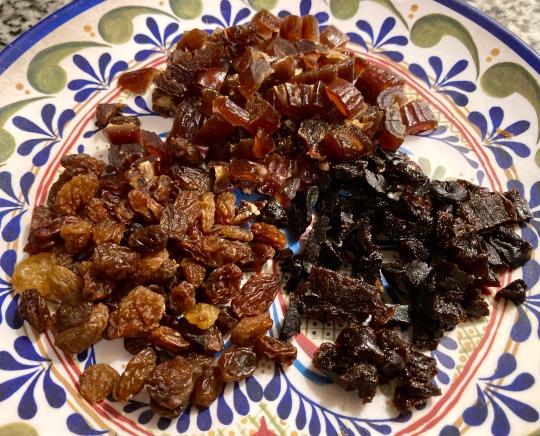
Instructions
1. Submerge wheat in water and scrub between your hands to clean and remove excess starch. Drain and cover by a couple inches with hot water. Cover and leave overnight.
2. Drain wheat and add to a large pot. Add water to cover and simmer for about 30 minutes until softened, stirring and adding more hot water as necessary.

Wheat before cooking
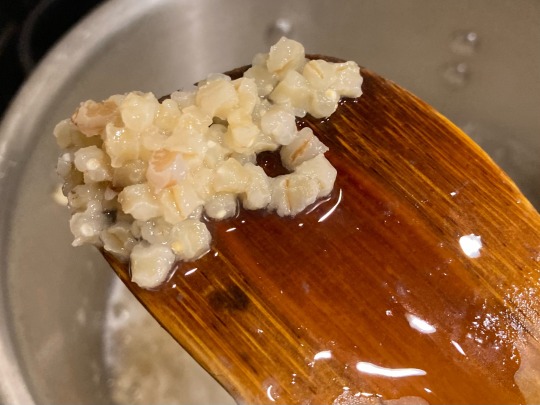
Wheat after cooking
3. Add dried fruit, sugar, salt, and spices and simmer for another 30 minutes, stirring occasionally, until wheat is very tender. Add water as necessary; the pudding should be relatively thin, but still able to coat the back of a spoon.
4. Remove from heat and stir in rosewater and honey. Ladle pudding into individual serving bowls and let cool in the refrigerator. Serve cold decorated with nuts and pomegranate seeds.
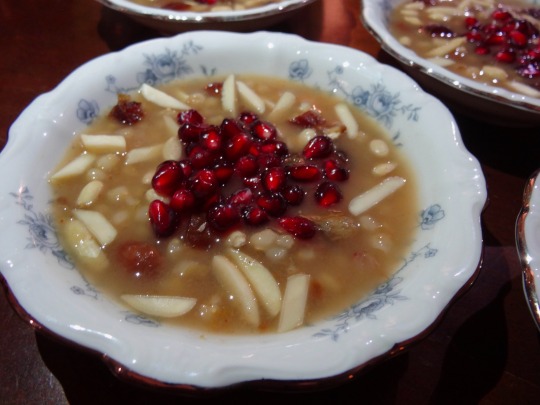
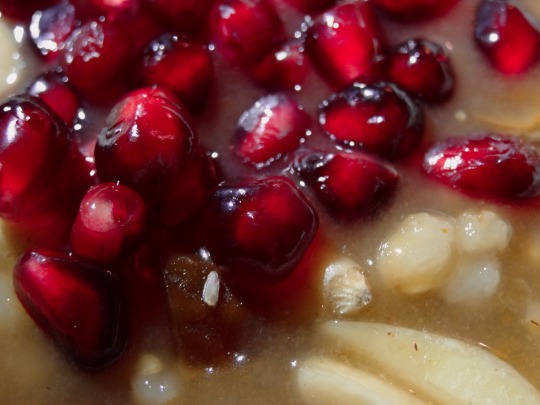
#the last link is a different / new fundraiser#Armenian#Palestinian#fusion#wheat berries#pearled wheats#pomegranate#prunes#dried apricot#dates#long post /
372 notes
·
View notes
Note
excuse me if im wrong but isnt togakure kinda weird considering hiro was like 20 when he met the thh cast and they were all like 16 including byakuya
spoilers for THH trial 6 (i think it was 6 or it mightve been 5 i dunno)
everyone thought they were around the 16 mark but in reality they were 18 or over due to the fact they had amnesia for the past 2-3 years. no one really know at what time in those 2-3 years they actually met, but i like to imagine they were around the 17 mark.
i dunno it’s a confusing subject and if you still think it’s weird thats totally understandable you don’t have to agree with the ship. but i’m not shipping them because of the age gap, frankly yasuhiro’s age is barely ever mentioned in the game i honestly forget about it. and i’m rambling again.
but to summarize: physically the cast was and is over 18 and i guess after the killing game they’d probably try to get back their memories making them somewhat mentally 18 too (thats just a headcanon tho).
again i don’t ship them as a 16 year old and a 21 year old, i do take the versions of them were they’re both consenting adults and they know they’re consenting adults (like in future ark or after the 6th (or was it 5th??) trial)
again it still can be seen as weird that’s your opinion you don’t have to agree with the ship, but that’s my view on the ship’s age gap.
37 notes
·
View notes
Text
Sky iceberg tier 5: Kizuna hair

Full iceberg
While making this iceberg, I asked some people who know more about Sky than I do if they could recommend things to add, and generally put things I’ve heard of but generally don’t know much about here, and sometimes I don’t have much to work with in terms of context. I trust they exist/happened, but if I say something confidently here or in the 6th tier preceded by “I’ve been told that…”, maybe take the finer details with a barrel of salt.
Ark mushrooms: During the season of enchantment, there were a few floating mushrooms around the forgotten ark, which when interacted with, would give you candles (shoutout to “littlecuteblue” for correcting me on this entry! I thought it was seasonal candles).
Blue seasonal candles: During the season of lightseekers, the seasonal candles were blue.
OneShot collab possible: It has been wanted for a long time for Sky and OneShot to collaborate. I’m pretty sure every Sky player upon finishing Solstice had the same realization, that these two pieces of media are really, really good for each other. Even one of the creators of the game, Nightmargin, plays Sky, and has expressed openness to doing a collaboration (or so I’ve been told)— which is what this entry is referring to! Sorry the original text was kind of clickbait-y.
Lost livestream: TGC did a livestream during Lightseekers (I think?) that was eventually taken down or otherwise “lost” for reasons I don’t know. A transcript (or something similar) for it was made though, and if you ask lorechat on skycord nicely they might give it to you.
Juggler OOB: Back before seasonal spirits were free to relive before they were traveling spirits, it was found that if you OOB in the right spot, you can find a memory from juggler floating in the void— and this was from when they were a very heavily wanted TS.
King statue: Ok I’m gonna be honest. I know this exists (or existed at one point), but I don’t remember what it is. All I know right now is that at some point, a statue of what appears to be the King was found, possibly via hacking.
King was a skykid: It’s a popular theory in the lore community that the King was a skykid, or even the first skykid, which is why they were able to complete the prophecy trials before anyone else— skykids are just like that, it’s easier for them (easier than for an ancestor, anyway).
This is a pretty small tier, so here’s a bonus entry that I decided not to include on the full iceberg:
Where is Aviary?: Aviary is seemingly connected to Harmony Hall—the OG, not like a pocket version, through a building, which is already kind of suspicious if you ask me, but HH is also connected to the village theater and the rest of the village of dreams from the back exit, which also works if you enter through Aviary… which is also connected to the Wind paths. Where the heck are we?!
55 notes
·
View notes
Text
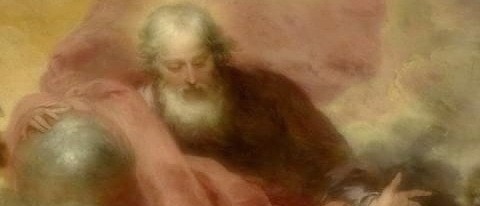
May Israel realize what they have done.
Centuries ago, Yahweh saved the Israelites (the ones who would later create Israel) from slavery of Egypt. Yahweh chose them as His main people just for them to disrespect Him centuries later. Gaza was made from Israel, Gaza are people of Yahweh too. Israel has completely ignored the 6th and 8th commandments of their Father. Thou shall not commit murder and thou shall not steal. If they truly loved their Father, they would take in consideration of the story of Noah's ark, they would know that their violence angers Yahweh.
Yahweh has done so much for His people and this is how they repay Him.
YAHWEH FOR PALESTINE!!! 🇵🇸🕊
#yahwehforpalestine#witchesforpalestine#yahweh#yahwist#witchcraft#witch#ancient religion#isrealites#deity worship#deity work#deity
28 notes
·
View notes
Text
New Doctor Who Tournament!
Hey there Whovians! Been rewatching a lot of Classic Who recently and I had an idea for a tournament I wanted to run! Doctor Who has always been a very serious and intellectual show, as we all know, and there is no better way to communicate a serious sci-fi message than by wearing a really goofy outfit made of tinfoil and PVC! So without further ado, let me introduce the
SILLIEST OUTFIT OF CLASSIC WHO TOURNAMENT!
You can follow along by following @sillydoctorwho or checking the hashtag #sillywho
Some tournament rules:
These must be outfits worn by humans/humanoids, not monster costumes. The silly monsters need a tournament of their own. (Silly hair and face paint don't exclude an outfit from contention, but if the character has significant facial prosthetics/ a mask then they count as a silly alien, not an alien in a silly costume)
There are a few costumes from classic who that are based off of racial stereotypes or are culturally insensitive, so it goes without saying we will be excluding those.
I have included a list of the outfits I have entered into the tournament below the cut, but if I have missed your favourite silly costume don't be afraid to let me know via an ask/messages and I'll add it in!
Have fun! May the stupidest costume win!
1st Doctor:
Altos - The Keys of Marinus
Drahvins - Galaxy 4
Judges - The Keys of Marinus
Moroks - The Space Museum
Robomen - The Dalek Invasion of Earth
Thals - The Daleks
Guardians - The Ark
2nd Doctor:
Astrid - The Enemy of the World
Atlantean Guard - The Underwater Menace
Brittanicus Base Operatives - The Ice Warriors
Caven - The Space Pirates
Celebration Dancers - The Macra Terror
Dominators - The Dominators
Dulcians - The Dominators
Madeleine Issigri - The Space Pirates
Ramo - The Underwater Menace
Spacesuits - The Moonbase
War Lord Guards - The War Games
3rd Doctor:
Guard Captain - The Curse of Peladon
Guards - Frontier in Space
Guards - The Mutants
IMC Guards - Colony in Space
Inspectors - The Mutants
King Peladon - The Curse of Peladon
Miners - The Monster of Peladon
Vorg and Shirna - Carnival of Monsters
4th Doctor:
Argolins - The Leisure Hive
Chancellery Guards - The Deadly Assassin
Hade - The Sunmakers
Morestrans - Planet of Evil
Movellans - Destiny of the Daleks
Passengers - Nightmare of Eden
Savants - Meglos
Skagra - Shada
Skonnan Guards - The Horns of Nimon
Station Medical Staff - The Invisible Enemy
Tesh - The Face of Evil
The Captain - The Pirate Planet
Time Lords - The Deadly Assassin
Toos - The Robots of Death
Uvanov - The Robots of Death
Zilda - The Robots of Death
5th Doctor:
Black Guardian - Mawdryn Undead
Citizens of Sarn - Planet of Fire
Dalek Troopers - Resurrection of the Daleks
Guards - Frontios
Kari and Olvir - Terminus
Lon (Ceremonial Robes) - Snakedance
Mawdryn and Mutants - Mawdryn Undead
Maxil (+Ermintrude) - Arc of Infinity
Portreeve - Castrovalva
6th Doctor:
Android - Timelash
Hugo Lang - The Twin Dilemma
Shockeye - The Two Doctors
Underground Folk - The Mysterious Planet
Valeyard - The Mysterious Planet
Ycarnos - Mindwarp
7th Doctor:
Bannermen - Delta and the Bannermen
Kangs - Paradise Towers
Lakertyans - Time and the Rani
The Happiness Patrol - The Happiness Patrol
Tollmaster - Delta and the Bannermen
@tournament-announcer
27 notes
·
View notes
Text

Basking in Malta's November sun are Phantoms FG.1s from No. 892 Squadron on board HMS Ark Royal at time of visit to Malta's Grand Harbour. I shot this on 6th November 1977 (Godfrey Mangion).
@CcibChris🇬🇧🏴via X
#fg.1 phantom#rolls royce#mcdonnell douglas aviation#Interceptor/fighter#faa#royal navy aircraft#aviation#aircraft#cold war aircraft#hms ark royal#🇬🇧
15 notes
·
View notes
Text
Camp NaNo Complete
I hit my 60,000 word count goal for the month! I wrote Acts 72 - 77 in 25 days! I am not looking forward to editing but that is going to be a Tuesday problem. I need some days of not looking at this story first.

Based on how writing went this month, this will be the posting schedule.
Teasers will be the week before the new act is posted. The first one will be posted on August 3rd for Act 72.
Act 72 - August 10th
Act 73 - August 24th
Act 74 - September 7th
Act 75 - September 21th
Act 76 - October 5th
Sailor Moon Villain's Week October 6th to 12th with some shorts related the mysterious purple haired lady
Act 77 - October 26th
Time to get editing and figure how much I want to share during villains week regarding our villain for this ark before the senshi meet her.
Act 78 will be started during the next NaNoWriMo in November, marking 10 years since I started Chaos Theory. I should probably outline some more chapters too so I'm ready to write in November. There is is so much left to go with this storyline!

#sailor moon#fanfics#fanfiction.net#fan fiction#fanfiction#fanfic#chaos theory#camp nano july 2024#camp nano#read on wattpad#read on ao3
9 notes
·
View notes
Text
Sera is NOT the ruler of heaven - Theory
Alright, so, regarding the hierarchy of angels, I don't think the Sera is like the ruler of heaven or the eldest; in the beginning, when Charlie talks about how Lucifer fell, he's talking about the eldest ones, these guys:

" Once upon a time, there was a glowing city protected by golden gates, known as Heaven. It was ruled by beings of pure light. Angels that worshiped good and shielded all from evil. Lucifer was one of these angels. He was a dreamer with fantastical ideas for all of creation. But, he was seen as a troublemaker by the elders of Heaven. For they felt his way of thinking was dangerous to the order of their world."
And now, in episode 5, when Lucifer tells Charlie about how his dreams were shattered, the six angels appear again, who, due to having six wings, are Seraphim. We can tell that they are the same ones from their crowns.

As we can see, Sera does not appear among them. She comes later when the discussion about the creation of the Earth begins, and she is together with the Ophanim.

So maybe she appeared later, considering there are older and younger Seraphim, like Emily. I believe the elders were the ones who expelled Lucifer and Lilith from heaven as punishment for what they did. Sera probably was afraid to tell Emily, fearing she might end up like Lucifer. She didn't want to lose another sibling. She sounds very scared for her when Emily defends the sinners. She probably thinks that if the elders find out, they will also cast her out for disobedience.

Perhaps Sera leads the department of humans, much like Lucifer leads the Pride Ring, while the elders handle other aspects, I don't know, the universe.
Regarding the other angels, I'll take the hierarchy from the wiki and try to identify what and how.
"The most influential Catholic angelic hierarchy was presented by Pseudo-Dionysius the Areopagite in the 5th or 6th century in his book "On the Celestial Hierarchy" (De Coelesti Hierarchia). Dionysius described nine levels of spiritual beings grouped into three orders:
Highest orders
Seraphim
Cherubim
Ophanim
Middle orders
Dominions
Virtues
Powers
Lowest orders
Principalities
Archangels
Angels"
1.Highest orders
Seraphim
In Vivzi's vision so far, it seems that Seraphim are the highest class of angels, with the oldest members, Sera, Emily, and Lucifer, belonging to this category.
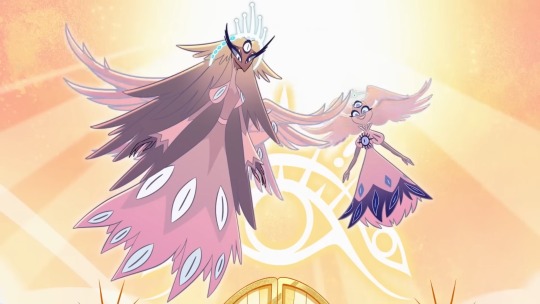
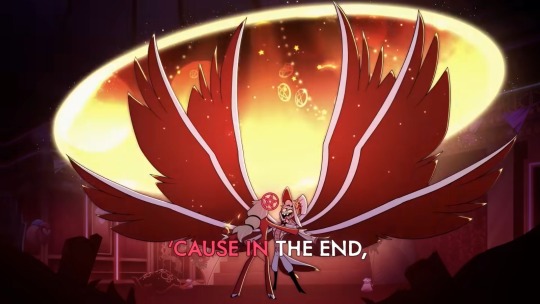

Cherubim
The book of Ezekiel provides the most detailed depiction of the Cherubim. They are described as having four different faces, wings covered with eyes, and legs like a calf’s, gleaming like burnished bronze. Ezekiel’s description of the Cherubim is arguably the most detailed in the Bible. It indicates that each Cherubim possesses four faces: a human, a lion, an ox, and an eagle.
Now I know, I know that in Helluva Boss, Vivziepop depicted Cherubs as cute creatures, not just having the four-faced aspect.

They also have only one pair of wings instead of two.
The wings of the Cherubim are another notable element in their descriptions across biblical literature. Cherubim are most often depicted with two or four wings.
In the Ark of the Covenant context, each Cherubim has two wings. The wings spread upwards, overshadowing the Mercy Seat, creating an intimate space that symbolizes the dwelling place of God.
In the visions of Ezekiel, the Cherubim have four wings. Two cover their bodies, and the other is used for flight, indicating their readiness to execute divine commands (Ezekiel 1:6).
Now, do you know who has four wings? These guys.

And these guys too.

They also look like eagles too.
I don't know, what do you think?
Ophanim
These guys:
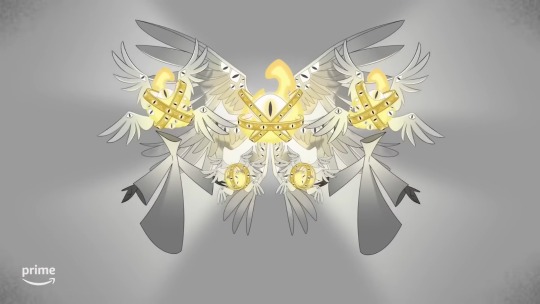
The Ophanim, also known as Thrones Angels, are often described as “wheels within wheels” or the “Many-Eyed Ones.”
Their unique appearance, filled with symbolism and profound meaning, represents a complex interplay between divine wisdom, cosmic order, and eternal movement.
In ancient texts, they are depicted as part of a celestial chariot, moving in harmony with other divine creatures such as the Cherubim. Their intricate design, filled with eyes, symbolizes divine omniscience, while their perpetual motion reflects the unending cycles of creation and transformation.

Now, what the hell is this guy?
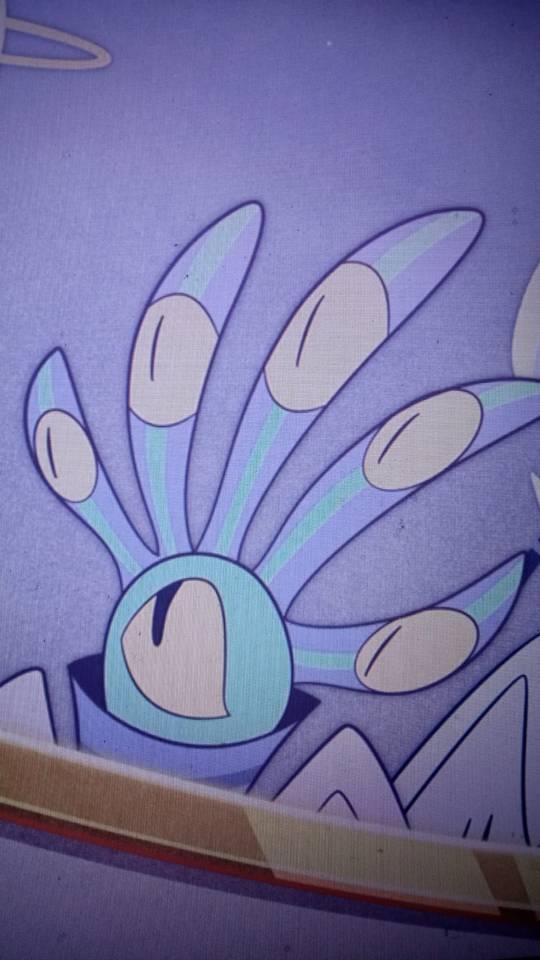
WHAT ARE YOUUUUUU?????

I will make a second part.
24 notes
·
View notes
Text

Up next on my 80's Fest Movie 🎥 marathon...Raiders Of The Lost Arkansas (1981) on glorious vintage VHS 📼! #movie #movies #actionadventure #raidersofthelostark #indianajones #indianajonesandtheraidersofthelostark #stevenspielberg #georgelucas #HarrisonFord #KarenAllen #PaulFreeman #AlfredMolina #johnrhysdavies #denholmelliott #vintage #vhs #80s #80sfest #durandurantulsas6thannual80sfest
#movie#movies#action adventure#raiders of the lost ark#indiana jones#indiana jones and the raiders of the lost ark#steven spielberg#george lucas#Harrison Ford#karen allen#paul freeman#alfred molina#john rhys davies#denholm elliott#vintage#vhs#80s#80s fest#duran duran tulsa's 6th annual 80s fest#Spotify
1 note
·
View note
Photo

The World's Oldest Love Poem
The world's oldest love poem is The Love Song for Shu-Sin (c. 2000 BCE) composed in ancient Mesopotamia for use in part of the sacred rites of fertility. Prior to its discovery in the 19th century, and its translation in the 20th, the biblical Song of Songs was thought to be the oldest love poem extant.
In the 19th century, archaeologists descended on the region of Mesopotamia seeking physical evidence which would corroborate the biblical narratives of the Old Testament. While this may not have been initially their driving purpose, their need for funding (based on public interest to justify such funding) soon made it so.
Instead of finding the evidence they hoped for, they discovered cuneiform tablets which established that many of the biblical narratives were derived from Mesopotamian sources. This discovery had a profound impact not only on biblical scholarship at the time but the history of the world as it was then understood.
Excavation & Discovery
When the archaeologist Austen Henry Layard began excavations at Kalhu in 1845, assisted by Hormuzd Rassam, he was under so much pressure to find biblical sites that he jumped to the conclusion the city he had uncovered was Nineveh. His published account of the excavations, in 1849, was titled Nineveh and its Remains and, owing to Nineveh's fame from the Bible, the book became a best seller. The success of the book sparked further interest in Mesopotamian history as a means of corroborating biblical narratives and so further expeditions were sent to the region in search of other cities mentioned in the Bible.
Prior to this time, the Bible was considered the oldest book in the world and The Song of Songs from the Bible (also known as The Song of Solomon) the oldest love poem. Interestingly, the expeditions sent to historically corroborate the stories from the Bible did precisely the opposite. When Layard excavated the actual site of Nineveh in 1846-1847, he discovered the library of the Assyrian king Ashurbanipal (r. 668-627 BCE) and the cuneiform texts, which were then translated by the legendary George Smith, made it clear that the story of the Fall of Man and The Great Flood and Noah's Ark were not original compositions of the authors of the Book of Genesis but were pre-existing Mesopotamian tales which were re-worked by later Hebrew scribes. The Song of Songs, dated to the 6th-3rd centuries BCE, could no longer be considered the oldest love poem once The Love Song for Shu-Sin (written c.2000 BCE) was discovered.
Continue reading...
85 notes
·
View notes
Text
World of Ashes Lore (my Oc world history) p12
Hi @the-invisible-introvert-2004 & @lucia1234lizeth
I'm having a bit of a problem with my arm. Because my cat threatened a stray cat that passed by the house. So I tried to bring it back into the house. The crazy cat bit me and injured me. Luckily, that's not my dominant arm. But it still hurts because I don't have any painkillers.
My Lore update might also be a bit shorter. But let's have fun.

CCTV images Recovered from the Special Investigations Unit. In the case at the ARK Space Research Center
M: June xxxx at 9:24 p.m., planet time. This is the 6th month since drillers entered the lunar sigma zone, “Helimily” or now “The Ruby” drilling center 01.
*Papers rub against each other*
M: *sigh* Well, come take a look. Mr.Jam...Marcus The night drilling supervisor reported that He had symptoms of fatigue and drowsiness, although the Earth Excavation Center confirmed that No overtime His latest physical examination results
*sound of paper flipping* It was reported that...he is in good health. There were no symptoms of solar wind allergy. But he was still as sleepy as ever, as were his co-workers, Mr. Smith and Mr. Evergreen. Those whose symptoms are relieved are now given medicine and given to rest and continue to monitor their symptoms.
M: Um...okay, the person who started acting strangely is *sighs and turns the page* Mr. Isaac, drilling equipment maintenance officer After traveling to repair drilling head number 4 at 12:00 a.m. during shift change, he reported that “He heard a whisper”?
M:…. Did he hear a man's voice?
*signal waves cannot be translated.*
M: What do you mean it's not "you"? *There's a knock at the door* Come in.
Xxx: Excuse me. *Sound of door opening* I see you need some advice.
M: Yes! Sorry, I feel like I'm not getting enough sleep. I'd like to go grab some documents for a moment.
_End recording_
11 notes
·
View notes